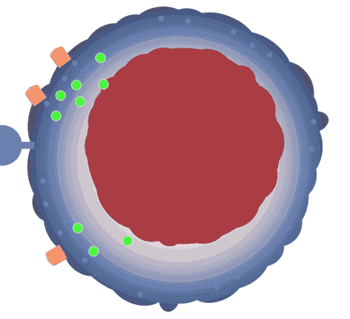 Cancer immunotherapy trains a patient’s immune system to fight tumors or overrides the mechanisms that cancer cells use to evade an immune response. When it works, the results are impressive. In January 2020, NIH Director Francis Collins, M.D., Ph.D., noted on his blog that immunotherapy “has dramatically changed the treatment landscape” for the most common type of lung cancer, non-small cell lung cancer, and credited immunotherapy for playing a role in driving lung cancer deaths in the United States to record lows. But for now, at least, immunotherapy is only recommended for a subset of cancer patients who meet specific criteria. Moreover, these treatments are expensive and side-effects, while rare, can be serious.
Cancer immunotherapy trains a patient’s immune system to fight tumors or overrides the mechanisms that cancer cells use to evade an immune response. When it works, the results are impressive. In January 2020, NIH Director Francis Collins, M.D., Ph.D., noted on his blog that immunotherapy “has dramatically changed the treatment landscape” for the most common type of lung cancer, non-small cell lung cancer, and credited immunotherapy for playing a role in driving lung cancer deaths in the United States to record lows. But for now, at least, immunotherapy is only recommended for a subset of cancer patients who meet specific criteria. Moreover, these treatments are expensive and side-effects, while rare, can be serious.
Benjamin Larimer, Ph.D., assistant professor of radiology and associate scientist in the O’Neal Comprehensive Cancer Center, has developed an imaging test that could help doctors identify the patients most likely to benefit from immunotherapy. Now he has received a five-year, $1.5-million National Institutes of Health Director’s New Innovator Award to advance this work. The New Innovator Award is part of the NIH’s “high-risk, high-reward” grant mechanisms designed to accelerate unusually innovative research on the part of exceptionally creative young investigators. Larimer is one of 53 recipients of New Innovator Award funding this year.
Granzyme B
Larimer has developed a diagnostic PET scan that records images of active granzyme B throughout the body. Granzyme B is a potent enzyme used by the immune system to induce the death of aberrant cells, such as cancer cells. Active granzyme B is an indication that the immune system has recognized cancer and is attempting to fight it. In his previous research, Larimer has demonstrated that the presence of granzyme B after immunotherapy is correlated with treatment success. (See Scan catches a cancer killer in the act to learn more about Larimer’s work.) A first-in-human clinical trial of granzyme B imaging in patients with metastatic melanoma and non-small cell lung cancer began at UAB in 2019.
“This would, in theory, allow for the personalization of treatment so patients who would benefit from immunotherapy can get the right treatment at the right time and so those who wouldn’t benefit can be treated with a different therapy that might be more effective,” Larimer said.
'Really important questions'
The NIH New Innovator Award funding will allow Larimer’s lab “to ask some really important questions,” he said.
The first question: “Can granzyme B tell who is most likely to benefit before people even start therapy?” Larimer said. That is, “does your immune system already recognize the cancer but just need a little boost to get rid of it?” The New Innovator Award funding will enable a clinical trial to investigate this question.
|
“This would, in theory, allow for the personalization of treatment so patients who would benefit from immunotherapy can get the right treatment at the right time and so those who wouldn’t benefit can be treated with a different therapy that might be more effective.” |
Another area of interest is predicting which patients are more likely to experience side effects during treatment. “Side-effects with immunotherapy are rare but can be really devastating,” Larimer said. “Can we tell who is going to have side-effects before they happen and help to prevent them?” Larimer’s lab will hire a new member to analyze images collected during clinical trials and look for signs of side-effects, such as “granzyme B uptake in the heart, lungs or colon that usually isn’t there,” Larimer said.
New Innovator Award funding also will enable a new project: comparing patient tumors that have high granzyme B with tumors that have low granzyme B “using advanced analysis techniques,” Larimer added. “Since we have this unique tool in granzyme B PET, can we use it to figure out what is different between the two and then test different treatment strategies in animal models to try and help those that immunotherapy doesn’t benefit?”

 Read more
Read more